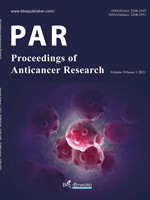Abstract
Objective: To study the effect of sal ammoniac extract on the treatment of liver cancer and analyze its possibility of replacing absolute ethanol. Methods: Sixty Kunming mice (5-6 weeks old, 18-22g in weight, male and female in half) were selected and inoculated with 0.1 ml of 1:4 ascitic diluent from mouse liver cancer H22 under the axilla of the right limb. After tumor formation, they were randomly divided into 3 groups with 20 mice in each group. Normal saline (NS), sal ammoniac extract (N), and absolute ethanol (E) were injected into the tumor once a day for four times. The death, tumor weight, tumor inhibition rate, lactate dehydrogenase (LDH), and succinate dehydrogenase (SDH) expression of the mice in each group were analyzed. Results: In the course of treatment, 3 mice died in the normal saline group, 2 mice died in the sal ammoniac treatment group, and 7 mice died in the absolute ethanol group. The tumor weight of the normal saline group, sal ammoniac treatment group, and absolute ethanol group were 1.88 ± 0.26, 1.41 ± 0.49, and 1.51 ± 0.46, respectively. The tumor inhibition rates were 0%, 31.0%, and 21.6%, respectively. Comparing the sal ammoniac treatment group and the normal saline group, t = 3.5133, p = 0.0013; comparing the absolute ethanol group and the normal saline group, t = 2.7926, p = 0.0093. The expression of LDH was 81 ± 10, 51 ± 11, and 32 ± 9 in the normal saline group, sal ammoniac treatment group, and absolute ethanol group, respectively, while the expression of SDH was 80 ± 10, 51 ± 10, and 51 ± 12 in the normal saline group, sal ammoniac treatment group, and absolute ethanol group, respectively. Comparing the LDH of the sal ammoniac treatment group with that of the saline group, t = 8.4264, p = 0.0000; comparing the absolute ethanol group and normal saline group, t = 13.8763, p = 0.0000. Comparing the SDH of the sal ammoniac treatment group with that of the normal saline group, t = 8.1455, p = 0.0000; comparing the absolute ethanol group with the normal saline group, t = 7.2197, p = 0.0000. Conclusion: The traditional Chinese antitumor medicine, sal ammoniac and its main effective components have good antitumor effect, which can be further popularized and applied in clinical practice.
References
Liang Y, Shen T, 2021, The Role and Mechanism of Mir-22 and Its Target Genes in Hepatocellular Carcinoma. Chemistry of Life, 41(06): 1252-1258.
Zhuo ET, Zheng YC, Fu GH, et al., 2021, Clinical Effect of Hepatic Arterial Chemoembolization Combined with Absolute Ethanol Ablation in Elderly Patients with Primary Liver Cancer. Chinese Journal of Gerontology, 41(14): 2956-2958.
Deng SR, Liu NJ, Li FY, et al., 1997, Qualitative Certification on the Traditional Chinese Medicine Sal Ammoniac. China Journal of Chinese Materia Medica, 22(05): 259-261.
Luo XQ, Ding GM, Zheng X, et al., 2021, Improvement of the Animal Model of Orthotopic Transplantation of Hepatic Carcinoma in Mice. Chinese Journal of Comparative Medicine, 31(06): 16-22.
Liu XH, Liu FY, 2021, Bioinformatics Analysis and Construction of autophagy Gene related Hepatocellular Carcinoma prognosis Assessment Model. Zhejiang Medicine, 43(12): 1320-1324, 1328, 1371.
Wang X, 2021, Comparative Study of RECIST1.1, mRECIST and qEASL Tumor Evaluation Criteria in the Evaluation of the Efficacy of TACE Combined with Microwave Ablation for Primary Liver Cancer. Northwest Minzu University.
Li WD, Guo XD, Chen JL, et al., 2021, Ct-Guided Percutaneous Absolute Ethanol Injection Combined with Radiofrequency Ablation for Primary Liver Cancer in High-Risk Sites. Chinese Journal of Minimally Invasive Surgery, 21(07): 605-609.
Wang H, 2021, Study on the Function and Mechanism of Long Chain Noncoding RNA GIMA Promoting the Survival of Liver Cancer Cells under Glucose Starvation. University of Science and Technology of China.
Tang HX, Li SS, Hong F, et al., 2021, Construction of a Novel Human Hepatocellular Carcinoma Xenotransplantation Model in Normal Immunized Mice. Journal of Clinical Hepatol, 37(11): 1-5.
